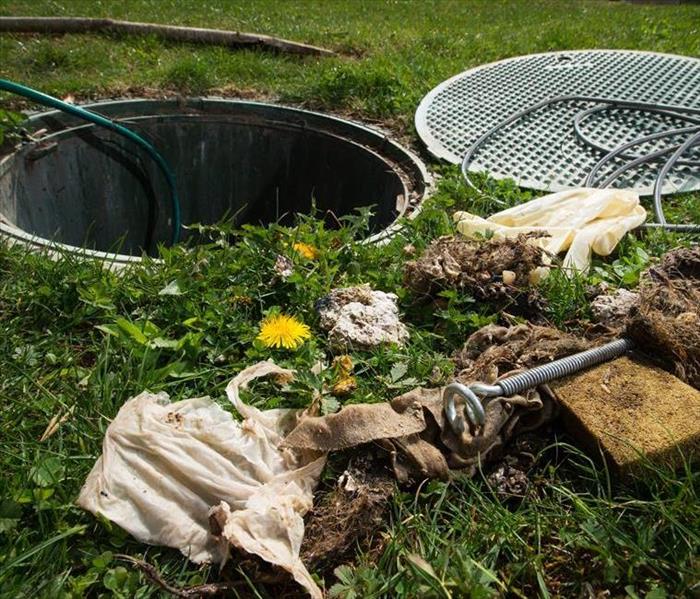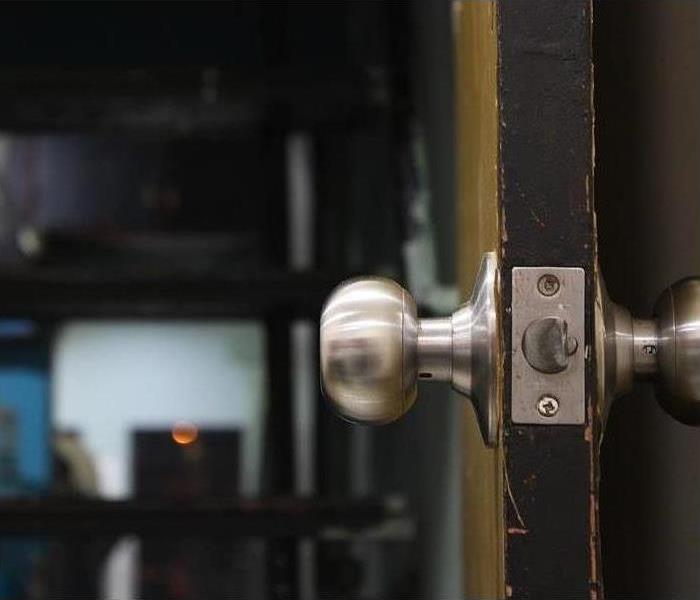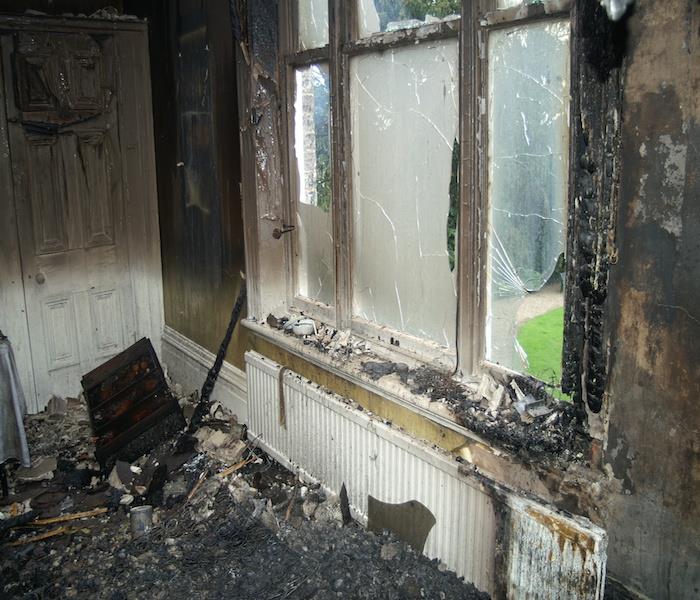Recent Cleaning Posts
Cleaning up after Septic and Sewage Back up
11/4/2020 (Permalink)
 Lid off the septic tank
Lid off the septic tank
Is It Possible To Clean up After Sewage Damage?
Cleaning up after a sewage disaster in your commercial building in Melbourne, FL, is possible, but more complicated than other water damage situations. This means that it is in your best interest to call in somebody who knows what they are doing, like a sewer cleanup restoration specialist. They will follow a procedure similar to the one outlined below.
Removal
If you've got a sewer backup, safety is a large consideration. Sewage is considered contaminated water, or black water. It's not good for people to be exposed to it. So, first, there are certain precautions you must take:
- Evacuate everyone who is not necessary away from the flooded area.
- Remove any additional hazards from the equation, such as shutting off electricity.
- Pump and drain out the contaminated water.
- Follow local toxic waste procedure to dispose of it.
Protection
When working on a sewer cleanup with black water, everyone must wear personal protective equipment. Try to leave no area of skin exposed- long rubber gloves and boots should be worn over long pants and sleeves. A pair of waders would be ideal. Goggles can be worn to protect the eyes. A face mask or respirator will help ensure that it does not reach the mouth or nose. If anyone were to be exposed, they should leave immediate to clean up.
Decontamination
After repairing your flooded toilet, when it's time for the cleaning stage, you will need to determine what can be saved and what must be thrown away. Porous materials such as ceiling tiles, drywall, and carpet may not be salvageable. Everything else must go through a multi-step process with specialized equipment to be treated for bacteria. Once that is done the contents can be thoroughly cleaned and dried. Hard surfaces like wood should then have a protective coating applied.
Sewer cleanup requires a specialized set of equipment, skills, and knowledge, so it is best not to attempt it yourself.
We here at SERVPRO of South Brevard
#SERVPROofsouthbrevard #septictanktip #sewagebackup #septictankbackupcleaning
Dirtiest Items in your Home
3/23/2020 (Permalink)
 How many people have touched your door knobs in your house?
How many people have touched your door knobs in your house?
Faucet Handles
Anyone who comes into your home and uses the bathroom may or may not wash their hands properly, therefore leaving behind germs all over your bathroom sink’s faucet handles. To wash mix 2 cups of warm water with 2 teaspoons of dishwashing liquid in a small bowl. Soak a washrag into the mixture and scrub the faucet. Use an old toothbrush dipped in baking soda to scrub areas with hard mineral deposits. Lastly, rinse the faucet and shine with a microfiber cloth.
Door Knobs
How often do you clean your door knobs? Most people simply do not think of their door knob when cleaning the house. Take a moment and think about how many people have touched your door knobs in the last month or two. That’s a lot of dirty hands. To wash spray the surface with vinegar and wipe dry with a clean cloth.
Pets Beds
Our pets are part of our family and we love them but we don’t have to love your beds. Their beds should be cleaned as often as we change our mattress sheets, right? Especially since our pets are outsides using the restroom several times a day and then go lay down in the beds. To wash, first vacuum the bed of all the hair and debris. Then remove the cover from the base of the bed (most beds have one) and put both in the washing machine (wash on sanitize cycle). Once washed, switch to the dryer and use a dryer sheet to reduce static electricity and remove excess hair.
Cutting Boards
Our cutting boards need a little more attention than we think, since its purpose it to cut the food that we eat on them. If not washed properly, bacteria can grow and affects our food. To wash properly scrubbing the wooden or plastic cutting boards with a paste made from baking soda, salt, and water (1 tablespoon each). Then Rinse thoroughly with hot water.
Sponges
Sponges are used to clean, but how often to you actually spend time cleaning the sponges, themselves. To wash, mix ¾ cup of bleach in one gallon of water, and soak the sponge for five minutes.
Remote Controls
Remote controls are one of the most hand held items in your house and with all those hands touching them how often are they cleaned? To clean use a lint-free cloth to wipe down the remote with rubbing alcohol (or use an electronics cleaning wipe). Make sure to clean the top, bottom, and sides of the remotes. For the buttons on the remote and any hard to reach areas, use a cotton swab.
Cleaning Up After a Fire
8/2/2016 (Permalink)
According to the National Fire Protection Association (NFPA), there are an estimated 370,000 house fires each year in the United States. These fires costs a total of $7 billion in total property damage. But what kind of fires are causing this damage and how are these fires cleaned up?
Types of Fires
There are three main types of fires that typically occur in homes across America; high-oxygen fires, low-oxygen fires, and kitchen fires. Each of these fires have their own aspects that allow them to create different types of damage. There are also different ways to properly clean them up.
A major factor that impacts the damage a fire causes is oxygen. Oxygen is part of the fire triangle of heat, fuel, and oxygen.
High-oxygen Fire
High-oxygen fires produce dry soot which makes these easier to clean than the other main types of house fires. They can typically be cleaned using a low-alkali detergent with dry sponges.
Low-oxygen Fire
A low-oxygen fire is a little more difficult to clean than a high-oxygen fire as it produces greasy, wet soot. This wet, smoky residue causes the fire to smolder. These fires are usually cleaned using a high-alkali detergent with warm water which can be used to wash walls and structures.
Kitchen Fire
Usually the most challenging type of fire damage to clean are kitchen fires. The biggest challenge of these fires come from the fact that the soot residue is difficult to detect. After kitchen fires, cabinets, drawers, and other appliances many times must be removed.
Cleaning Fires
Most of the damage that comes from fires doesn’t come from the actual flames but from the smoke and soot that the fire produces. This smoke and soot has the ability to penetrate the paint, carpet, upholstery, and clothes throughout the house. While some material in the affected home will need to be removed and disposed of, other materials are able to be cleaned. When the cleaning process takes place, there are some key aspects regardless of where the fire occurs.
Personal Protective Equipment (PPE)
Safety is the most important aspect when cleaning up a fire. Anyone cleaning up a fire should wear gloves, a protective mask, long-sleeved shirts, and pants. This equipment will help to minimize contact with the mold that could be dangerous. Again, professionals are trained to deal with mold so that it doesn’t harm them or anyone else in the house which is a major reason why only professionals should deal with mold.
Remove Contents from the Home
Regardless of what the material is that has been damaged, all contents inside the home should be removed. However, depending on what the specific material is that is being dealt with, it may not need to be discarded. While some materials do need to be discarded following a fire, others are able to be cleaned.
Ventilation
Ventilation is a key part of, not just putting out a fire, but also restoring a home after a fire. Smoke and soot create an uninhabitable environment in the building which is in need of fresh air. When the firefighters arrive on the scene, they will begin the ventilation process immediately to make the building safer. After they leave, ventilating will help by removing odors.
Additional Contaminants
While smoke and soot are responsible for the majority of the damage, lead and asbestos also can create an environment that is in need of restoration. If they become disturbed, what began as a simple fire restoration could become a serious environmental restoration.
Duct Cleaning
The smoke and soot that are a result of a fire can get trapped in the duct system of the building. Because of this, a thorough duct cleaning is required after any fire restoration. If a duct cleaning is not completed, there’s the possibility that contaminants and odors can spread to other areas of the home.
A fire in the home can be a devastating event. Depending on what type of fire occurs, the damage can force a small clean up or a total clean up. Either way, there are certain aspects of the restoration that will need to be completed. If you suffer a fire in your home, call on the professionals at SERVPRO to ensure a complete restoration.
Why You Should Call Professionals to Clean Your Rug
4/15/2016 (Permalink)
Water damage can cause serious harm to your house’s foundation and compromise the structural integrity of the home. It can cause damage to your walls, roof, and to the floor. But water damage doesn’t just affect the structural parts of your home.
If you’ve suffered water damage in your home, you might’ve suffered some damage to personal belongings. One such belonging, carpet or upholstery, should be cleaned by the professionals at SERVPRO rather than attempting to do it yourself. Regardless of how well you think you might be able to restore the item, the results won’t be as good as if you hire professionals to do the job. No matter how large the item is or how much it costs, the professional technicians at SERVPRO can clean, repair, and restore the item to preserve its condition and prolong its lifespan.
One of the most popular types of carpeting to see in homes are area rugs. They come in all different sizes and designs and can be used for decorative and practical purposes. They’re often used to keep other furniture such as tables and chairs from damaging hardwood floors. But they also collect dirt, odors, allergens, and discolorations due to the fact that so many people step on them each and every day.
Routine vacuuming and spot treatment are helpful to keeping the rug looking nice but that type of maintenance can only go so far. At the end of the day, you’ll need skilled technicians that have the professional training necessary to complete comprehensive maintenance every so often. The more people continue to step on the rug, the more often it will be in need of a good, professional cleaning.
Our highly trained, professional, IICRC certified technicians will begin the process of restoring your rug by analyzing the material that’s been damaged and determining what kind of repairs and/or cleaning needs to be undertaken to restore the rug to its original state. They’ll start the cleaning process with a thorough vacuuming, spot removal, and other repairs before giving the rug a good rinse. Next a pre-tested product is applied that is specially used by professional cleaners. They’ll work in this product using a gentle agitating brush before rinsing and drying the rug.
The majority of the water that’s being held within the fibers of the fabric will be drawn out using a centrifuge or other means that the professionals on site deem necessary. Then it will be hung for final drying. If improper techniques are used for drying, it can do irreparable damage to the material so it’s important that a professional that knows the exact way to clean and dry the rug so that it’s restored to its original state. Attempting to clean and dry the rug yourself can damage the appearance of the rug and ruin the rug leaving you having to purchase a new, expensive rug.
You’ll want the rug clean and dry so it can continue to serve its purpose of protecting your floor but you likely also want the rug to look nice as area rugs often are also used as a decorative piece. Our professionals that are restoring the rug will give the rug an appearance touch up like final pile brushing and combing the fringe prior to returning the rug to its owner.
While it may seem like cleaning a rug is a simple process that you can do yourself, that’s a surefire way of ruining your beautiful, expensive product. Therefore, it’s important that you hire professionals that are trained in this type of work. Companies that are certified by the Institute of Inspection Cleaning and Restoration Certification (IICRC), like SERVPRO, are aware of the latest techniques and equipment, have the proper skills, and abide by IICRC’s strict standards for cleaning and restoration.
An area rug can be a great addition to your home serving the purpose of protecting your hardwood floor while also adding beautiful decoration to the house. But, as with your house, water can be the nemesis to the well being of your rug. You may think that you can clean and dry the rug yourself but to ensure that the rug is restored to its original state, an IICRC-certified firm needs to be brought in to handle the job. If you need a rug restored or need water, fire, or mold remediation, call SERVPRO to help.






 24/7 Emergency Service
24/7 Emergency Service



